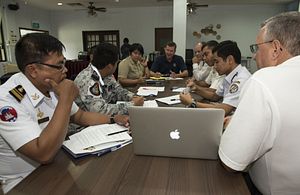Earlier this month, the United States and South and Southeast Asian states kicked off this year’s iteration of the Southeast Asia Cooperation and Training (SEACAT) exercises. The drills put the spotlight on ongoing efforts by the United States and Southeast Asian countries to boost maritime security collaboration within the wider Indo-Pacific region.
As I have noted before in these pages, SEACAT is one of a series of multilateral exercises that the United States carries out with Asian countries, including those from Southeast Asia. The exercise, which began as “Southeast Asia Cooperation Against Terrorism” in the post-9/11 period back in 2002, was subsequently renamed in 2012 to reflect the focus on advancing training among regional navies and coast guards in South and Southeast Asia to manage various challenges, including piracy and illegal smuggling.
Over the past few weeks, this aspect of U.S. defense ties with Southeast Asian states was in the headlines again with the holding of this year’s iteration of the SEACAT exercise. The exercise, which is in its 18th iteration, kicked off on August 19 and is to last until August 30. It features participation from a range of countries, including eight Southeast Asian states – Brunei, Cambodia, Indonesia, Malaysia, the Philippines, Singapore, Thailand, and Vietnam – along with Bangladesh and Sri Lanka. This constituted an increase from last year, with Cambodia an addition this year even amid continuing differences between Washington and Phnom Penh, which extend into the security side of ties.
The exercise itself consisted of various components. Per the U.S. Navy, there were a series of workshops, including a maritime security professional development workshop held in Singapore and a vessel board, search, and seizure workshop in the Philippine capital of Manila. The sea phase of the exercise kicked off in the Malacca Straits and the South China Sea on August 26, which focused on various scenarios to strengthen interoperability in areas such as visit, board, search, and seizure (VBSS), maritime domain awareness, and maritime asset tracking. This phase of the exercise focused on realistic scenarios where participants practiced identifying, tracking, and boarding vessels participating in the exercise.
Like previous iterations of the exercise, there was a focus on using operations centers from participating navies and coast guards in order to both carry out the exercise and to assess their roles in promoting practical information sharing in addressing maritime challenges. This included the Philippine National Coast Watch Center and the Combined Maritime Coordination Center in Singapore set up at the RSN’s Changi Command and Control Center (CC2C) – the 10th consecutive year that the exercise command post has been set up there. Per Singapore’s defense ministry (MINDEF), officers from various countries used the Information Fusion Center Real-Time Information-Sharing System to fuse and process information.
All in all, according to the U.S. Navy statement, SEACAT this year includes 14 ships and more than 400 personnel, with U.S. Navy units including the staff of Destroyer Squadron 7, P-8 Poseidon aircraft assigned to Task Force 72, and personnel from Task Force 73, along with participants from the U.S. Coast Guard including Maritime Security Response Team West and Pacific Tactical Law Enforcement Team. This year’s SEACAT also comes ahead of the first-ever U.S.-ASEAN maritime exercise, which is expected to take place next week.

































